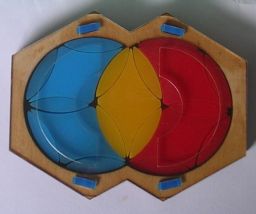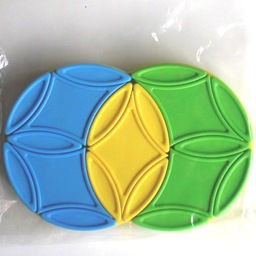



This is a puzzle consisting of two overlapping circular disks, reminiscent of other
circle puzzles such as Turnstile and Rashkey.
It actually most resembles the Cohan Circle but instead of 6-fold
symmetry it has 3 fold symmetry, so it is as if you are playing on a Cohan Circle but restrict
yourself to only do 120 degree turns.
Each disk consists of 3 large diamond shaped pieces, and 9 small lozenge shaped pieces of
which 6 form the perimeter of the disk and 3 form spokes between the diamond pieces. The
two disks share a diamond and its four adjacent lozenges, so all together there are 5
diamonds and 14 lozenges.
The puzzle usually has three colours. In the solved state the overlapping area is one colour,
and the rest of the left disk a second colour, and the rest of the right disk a third colour.
The Triplex puzzle was invented by Douglas A. Engel, who also invented various other puzzles such as:
Mandorla is a neat version of the puzzle was produced in Hungary in 2013. It was invented by Ferenc Molnár, who also invented the Equator / Hungarian Globe puzzle.
If your browser supports JavaScript, then you can play the Mandorla/Triplex puzzle by clicking the link below:
There are 5 diamonds, and 14 lozenges. The lozenges however are split into two orbits
of 7 pieces which cannot intermingle.
Only even permutations are possible in each of the three orbits. If the pieces
were all unique this would give at most 7!2·5!/23 = 381,024,000
possibilities, and all of these positions are indeed attainable.
The standard version of the puzzle however has many identical pieces. The
set of 5 diamonds splits into 2+1+2 pieces of each colour, and the two sets of
7 diamonds each split as 4+2+1 into the three colours. This gives a total of
7!2·5! / (2!4·4!2) = 330,750
possible positions.
I used a computer to calculate God's algorithm for the puzzle, and the results are shown in the tables below. The 3-colour version needs at most 21 moves to solve (16.217 on average), and a version with unique pieces needs at most 33 moves (26.409 on average).
| 3-colour version | Full version | |||||||||||||||||||||||||||||||||||||||||||||||||||||||||||||||||||||||||||||||||||||||||||||||||||||||||||||||||||||||||||
|---|---|---|---|---|---|---|---|---|---|---|---|---|---|---|---|---|---|---|---|---|---|---|---|---|---|---|---|---|---|---|---|---|---|---|---|---|---|---|---|---|---|---|---|---|---|---|---|---|---|---|---|---|---|---|---|---|---|---|---|---|---|---|---|---|---|---|---|---|---|---|---|---|---|---|---|---|---|---|---|---|---|---|---|---|---|---|---|---|---|---|---|---|---|---|---|---|---|---|---|---|---|---|---|---|---|---|---|---|---|---|---|---|---|---|---|---|---|---|---|---|---|---|---|---|
|
|
| ||||||||||||||||||||||||||||||||||||||||||||||||||||||||||||||||||||||||||||||||||||||||||||||||||||||||||||||||||||||||||
This solution assumes that you are using a version with 3 colours. If your puzzle has more colours, then this solution will not work. Further down this page I will give move sequences that cleanly swap some pieces, and those should suffice to solve any version of this puzzle.
Phase 1: Solve the five lozenge pieces in the left disk.
Phase 2: Solve the remaining lozenge pieces.
Phase 3: Solve the diamond pieces.
The sequences of phase 3 above move the diamonds without affecting the lozenges at all. Therefore I will list some sequences here that perform 3-cycles of lozenges, with or without affecting diamonds. These are useful if you have a puzzle with a different colour design for which the solution above does not work.